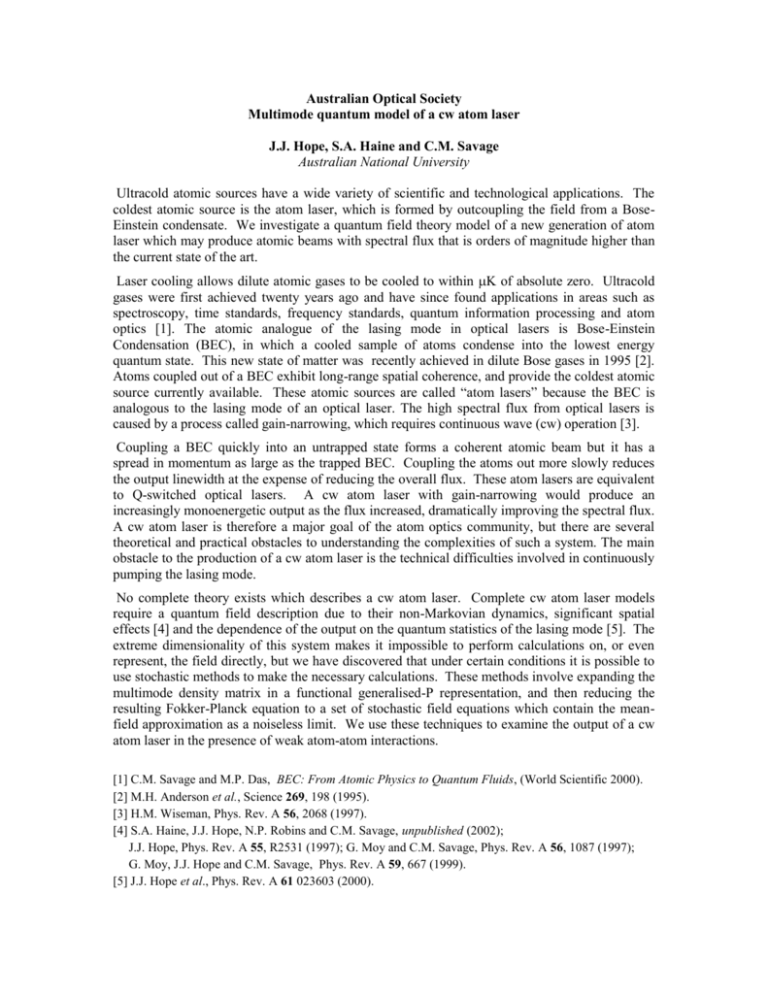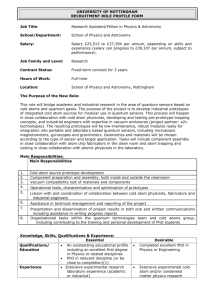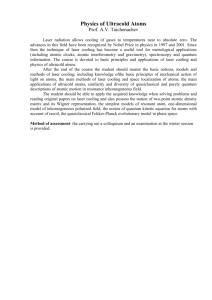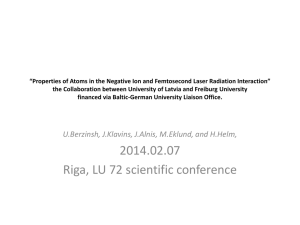AIP00152
advertisement

Australian Optical Society Multimode quantum model of a cw atom laser J.J. Hope, S.A. Haine and C.M. Savage Australian National University Ultracold atomic sources have a wide variety of scientific and technological applications. The coldest atomic source is the atom laser, which is formed by outcoupling the field from a BoseEinstein condensate. We investigate a quantum field theory model of a new generation of atom laser which may produce atomic beams with spectral flux that is orders of magnitude higher than the current state of the art. Laser cooling allows dilute atomic gases to be cooled to within K of absolute zero. Ultracold gases were first achieved twenty years ago and have since found applications in areas such as spectroscopy, time standards, frequency standards, quantum information processing and atom optics [1]. The atomic analogue of the lasing mode in optical lasers is Bose-Einstein Condensation (BEC), in which a cooled sample of atoms condense into the lowest energy quantum state. This new state of matter was recently achieved in dilute Bose gases in 1995 [2]. Atoms coupled out of a BEC exhibit long-range spatial coherence, and provide the coldest atomic source currently available. These atomic sources are called “atom lasers” because the BEC is analogous to the lasing mode of an optical laser. The high spectral flux from optical lasers is caused by a process called gain-narrowing, which requires continuous wave (cw) operation [3]. Coupling a BEC quickly into an untrapped state forms a coherent atomic beam but it has a spread in momentum as large as the trapped BEC. Coupling the atoms out more slowly reduces the output linewidth at the expense of reducing the overall flux. These atom lasers are equivalent to Q-switched optical lasers. A cw atom laser with gain-narrowing would produce an increasingly monoenergetic output as the flux increased, dramatically improving the spectral flux. A cw atom laser is therefore a major goal of the atom optics community, but there are several theoretical and practical obstacles to understanding the complexities of such a system. The main obstacle to the production of a cw atom laser is the technical difficulties involved in continuously pumping the lasing mode. No complete theory exists which describes a cw atom laser. Complete cw atom laser models require a quantum field description due to their non-Markovian dynamics, significant spatial effects [4] and the dependence of the output on the quantum statistics of the lasing mode [5]. The extreme dimensionality of this system makes it impossible to perform calculations on, or even represent, the field directly, but we have discovered that under certain conditions it is possible to use stochastic methods to make the necessary calculations. These methods involve expanding the multimode density matrix in a functional generalised-P representation, and then reducing the resulting Fokker-Planck equation to a set of stochastic field equations which contain the meanfield approximation as a noiseless limit. We use these techniques to examine the output of a cw atom laser in the presence of weak atom-atom interactions. [1] C.M. Savage and M.P. Das, BEC: From Atomic Physics to Quantum Fluids, (World Scientific 2000). [2] M.H. Anderson et al., Science 269, 198 (1995). [3] H.M. Wiseman, Phys. Rev. A 56, 2068 (1997). [4] S.A. Haine, J.J. Hope, N.P. Robins and C.M. Savage, unpublished (2002); J.J. Hope, Phys. Rev. A 55, R2531 (1997); G. Moy and C.M. Savage, Phys. Rev. A 56, 1087 (1997); G. Moy, J.J. Hope and C.M. Savage, Phys. Rev. A 59, 667 (1999). [5] J.J. Hope et al., Phys. Rev. A 61 023603 (2000).









